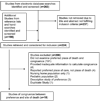Factors associated with congruence between preferred and actual place of death
- PMID: 20116205
- PMCID: PMC2843755
- DOI: 10.1016/j.jpainsymman.2009.07.007
Factors associated with congruence between preferred and actual place of death
Abstract
Congruence between preferred and actual place of death may be an essential component in terminal care. Most patients prefer a home death, but many patients do not die in their preferred location. Specialized (physician, hospice, and palliative) home care visits may increase home deaths, but factors associated with congruence have not been systematically reviewed. This study sought to review the extent of congruence reported in the literature and examine factors that may influence congruence. In July 2009, a comprehensive literature search was performed using MEDLINE, PsychInfo, CINAHL, and Web of Science. Reference lists, related articles, and the past five years of six palliative care journals were also searched. Overall congruence rates (percentage of met preferences for all locations of death) were calculated for each study using reported data to allow cross-study comparison. Eighteen articles described 30%-91% congruence. Eight specialized home care studies reported 59%-91% congruence. A physician-led home care program reported 91% congruence. Of the 10 studies without specialized home care for all patients, seven reported 56%-71% congruence and most reported unique care programs. Of the remaining three studies without specialized home care for all patients, two reported 43%-46% congruence among hospital inpatients, and one elicited patient preference "if everything were possible," with 30% congruence. Physician support, hospice enrollment, and family support improved congruence in multiple studies. Research in this important area must consider potential sources of bias, the method of eliciting patient preference, and the absence of a single ideal place of death.
(c) 2010 U.S. Cancer Pain Relief Committee. Published by Elsevier Inc. All rights reserved.
Figures
References
-
- Weitzen S, Teno JM, Fennell M, Mor V. Factors associated with site of death: a national study of where people die. Med Care. 2003;41(2):323–335. - PubMed
-
- Field M, Cassel C. Approaching death: Improving care at the end of life. Washington DC: National Academy Press; 1997. - PubMed
-
- Tang ST, McCorkle R. Determinants of congruence between the preferred and actual place of death for terminally ill cancer patients. J Palliat Care. 2003;19(4):230–237. - PubMed
-
- Higginson IJ, Sen-Gupta GJ. Place of care in advanced cancer: a qualitative systematic literature review of patient preferences. J Palliat Med. 2000;3(3):287–300. - PubMed
-
- Foreman LM, Hunt RW, Luke CG, Roder DM. Factors predictive of preferred place of death in the general population of South Australia. Palliat Med. 2006;20(4):447–453. - PubMed
Publication types
MeSH terms
Grants and funding
LinkOut - more resources
Full Text Sources
Miscellaneous


